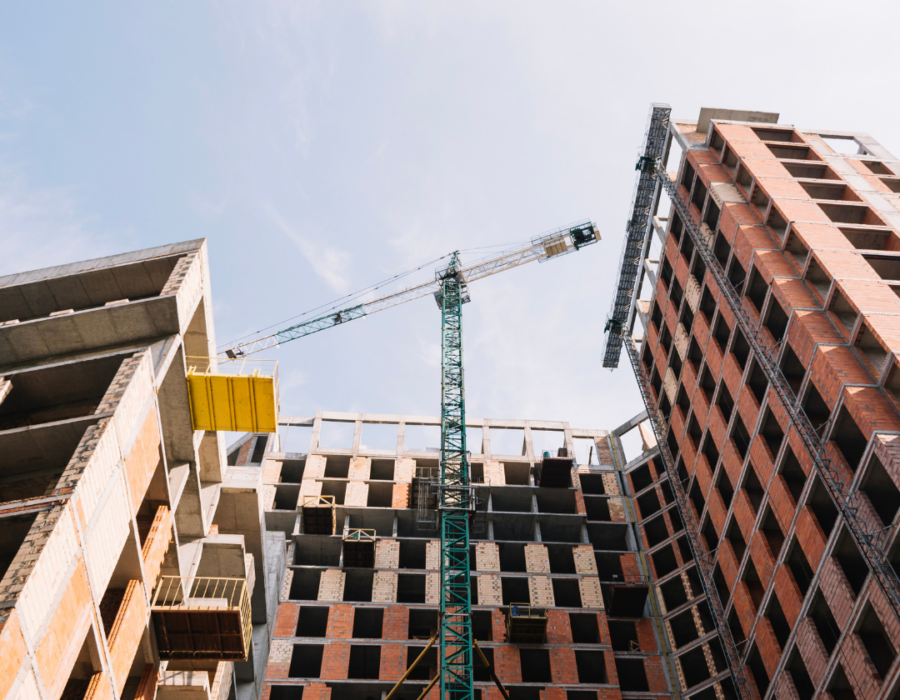Our industry is engaged in an important dialogue to improve sustainability through ESG transparency and industry collaboration. This article is a contribution to this larger conversation and does not necessarily reflect GRESB’s position.
Embodied carbon and Life Cycle Assessments
According to the European Commission, the construction sector is responsible for 36% of greenhouse gas emissions in Europe (European Parliament, 2024), with an increasing portion attributed to embodied carbon—the impact of building materials. Historically, the focus has been on operational carbon emissions from the energy consumed during a building’s lifecycle. However, as regulations increasingly address operational carbon, attention is shifting toward embodied carbon.
Embodied carbon refers to the total greenhouse gas emissions resulting from the extraction, production, and transportation of building materials, as well as their disposal at the end of a building’s life. To accurately assess and reduce embodied carbon, companies must employ Life Cycle Assessments (LCA). An LCA evaluates the environmental impacts of a building across its entire life cycle, considering multiple phases from raw material extraction to construction, usage, and eventual demolition.
Context
With the urgency of the climate crisis and the introduction of new EU regulations, addressing embodied carbon has become essential. The EU’s Fit for 55 package and the Green Deal set ambitious carbon reduction targets: 55% by 2030 and 100% by 2050 (European Council, 2024; European Commission, 2024). As part of these goals, the EU will mandate the measurement of embodied carbon in new buildings over 1,000 square meters by 2028. From 2030, each member state will also establish a maximum threshold for embodied carbon, which will progressively decrease over time. Reducing embodied carbon is therefore not just a matter of compliance; it’s crucial for businesses to stay competitive in a rapidly shifting market.
Relying solely on regulatory compliance would lead to a dangerous +3°C warming by 2100, bringing severe impacts on ecosystems, economies, and public health. Under a +1.5°C scenario, intense droughts are projected for regions like the Mediterranean, alongside a 0.5-meter rise in sea levels and a 90% loss of coral reefs worldwide—serious but still manageable consequences. By contrast, a +3°C scenario implies a 7-meter sea level rise, loss of half the Himalayan glaciers, and potential marine ecosystem collapse, which would threaten food security, drive climate migration, and destabilize geopolitics. Proactive private initiatives are therefore essential to achieve the +1.5°C pathway (Climate Nexus, 2024).
Framework jungle
Better to be a frontrunner than a follower—but which methodologies and targets best address embodied carbon? The drive to reduce it is well-intentioned, yet navigating the growing number of frameworks, certifications, and regulations can be overwhelming. Standards like EN 15978 and ISO 20887 provide LCA guidance, but they are just the beginning. There are additional frameworks like BREEAM, Levels (EU), DGNB, LCBI, or country-specific regulations in France, the Netherlands, and Denmark. Additionally, to connect embodied carbon targets to the Paris Agreement, initiatives like the Science Based Targets (SBTi) offer structured decarbonization pathways (EN Standard, 2011; ISO, 2020; BREEAM Knowledge Base, 2023; European Commission JRC, 2020; DGNB, 2020; Low Carbon Building Initiative, 2024).
All in all, businesses are often left wondering which frameworks to follow and how to align their strategies with multiple benchmarks. To ensure consistency and comparability, companies need to adopt a transparent LCA methodology that communicates clearly which frameworks and hypotheses are being used and how results are calculated.
Embodied carbon strategy
A successful embodied carbon strategy involves a clear and actionable plan. Here’s how companies can structure their approach:
1. Clear LCA methodology
The foundation of any embodied carbon strategy is a transparent LCA methodology. This methodology should align with the company’s activities. A safe guess is to remain close to Level(s), the framework required by the EU regulation and taxonomy. Transparency is critical here—when conducting LCAs, companies must communicate clearly about the variables used, such as the type of lifespan for materials or the elements of the building included in the LCA. By doing so, LCA results are consistent, comparable, and actionable.
2. Clear ambition
Setting an ambitious target is the next step. The Paris Agreement provides a roadmap for achieving net-zero emissions by 2050. By adopting SBTi’s science-based targets for embodied carbon, businesses can position themselves as frontrunners, driving industry change rather than merely complying with regulations. This marks a transition towards a solid and meaningful ambition, based on science and in line with the EU Fit for 55, the Green Deal, and the Paris Agreement (European Council, 2024; European Commission, 2024; UNFCCC, 2015).
3. Clear action plan
An actionable decarbonization plan should focus on improving the carbon performance of the entire construction portfolio. The plan should include several key steps:
- Define the LCA methodology of the company and make it clear to the companies performing the LCAs.
- Fix an ambition for the construction portfolio: Set yearly targets for carbon reductions at the portfolio level, ensuring that all new projects align with the company’s long-term decarbonization goals.
- Perform an LCA on each new construction and significant renovation: LCAs should be mandatory for all new builds and significant renovations, ensuring a consistent approach to measuring and reducing embodied carbon.
- Study material improvement possibilities through material guidance: Continuously evaluate and improve material choices, favoring low-carbon, bio-based, and recycled materials. By following material guidance, such as reducing the use of high-carbon materials like cement and steel, companies can make informed decisions that have a tangible impact on their projects.
4. Reach your ambition
Once the strategy is set, it’s essential to ensure that each project contributes to future improvements. This can be achieved by following a few key priorities:
- Ensure each project improves the next: Gather data and lessons learned from each project to inform future developments, ensuring continuous improvement.
- Set priorities based on the hierarchy of sustainability: Focus on preserving existing structures wherever possible, reducing new material use, reusing materials, and prioritizing bio-based, recycled, and low-carbon options. This not only reduces emissions but also promotes a circular economy.
Takeaways and projections
Reducing embodied carbon is a complex yet essential task in the fight against climate change. By establishing clear targets aligned with the Paris Agreement and employing a transparent LCA methodology, companies can make substantial progress. Continuous improvement must remain a central theme—each project should inform the next, fostering innovation and advancement throughout the organization.
Humanity is at a crucial turning point, engaged in a phase of transition in our society. Our perception of the world is destined to evolve continuously. What we believed five years ago no longer corresponds to our current reality, and in five years’ time, our vision will have evolved again. It is therefore essential to approach the next 25 years of decarbonization with an open mind, accepting that the choices we find logical today may appear illogical in the future, and vice versa. Certain areas for improvement will likely be decisive in the success of this decarbonization in the construction sector:
- The communalization of reuse on a large scale to facilitate matchmaking between supply and demand in construction projects.
- More reports agree that a path to reducing carbon emissions based on sobriety will cost less to implement in Europe. This means moving towards materials that require little energy to produce and ensuring that they are made entirely from renewable energy.
- Re-learning to build with raw and abundant materials, such as compressed raw earth.
- Transitioning to ‘materials as a service’ business models.
- When designing buildings, decompose them into layers where each layer must be distinct and demountable, favoring assemblies such as clips and dry connections.
While addressing embodied carbon is crucial for mitigating climate change, it’s important to remember that climate change is just one of the planetary boundaries. The environmental impact of the building sector goes beyond carbon emissions—it also affects biodiversity, water resources, and land use. By adopting a holistic approach that incorporates multiple sustainability metrics, companies can ensure that they are contributing to a broader environmental solution, not just reducing their carbon footprint.
Conclusion
In conclusion, those who embrace proactive strategies for reducing embodied carbon will not only help combat climate change but also position themselves as leaders in the sustainable building industry. Waiting for regulations to catch up is a risky strategy. The time to act is now—by setting clear ambitions and implementing transparent, effective action plans, companies can secure their place as frontrunners in an increasingly competitive market.
This article was written by Hadrien Cruyt, Sustainability Consultant at SuReal.
References:
European Parliament. 2024. “MEPs Back Plans for a Climate Neutral Building Sector by 2050.” Accessed November 19, 2024. https://www.europarl.europa.eu/news/en/press-room/20240101IPR97123/meps-back-plans-for-a-climate-neutral-building-sector-by-2050.
European Council. 2024. “Fit for 55.” Accessed November 19, 2024. https://www.consilium.europa.eu/en/policies/fit-for-55/.
European Commission. 2024. “The European Green Deal.” Accessed November 19, 2024. https://commission.europa.eu/strategy-and-policy/priorities-2019-2024/european-green-deal_en.
Climate Nexus. 2024. “Comparing Climate Impacts at +1.5°C, +2°C, +3°C, and +4°C.” Accessed November 19, 2024. https://climatenexus.org/international/ipcc/comparing-climate-impacts-at-1-5c-2c-3c-and-4c/.
EN Standard. 2011. BS EN 15978: Sustainability of Construction Works. Assessment of Environmental Performance of Buildings. Calculation Method. Accessed November 19, 2024. https://www.en-standard.eu/bs-en-15978-2011-sustainability-of-construction-works-assessment-of-environmental-performance-of-buildings-calculation-method/.
International Organization for Standardization (ISO). 2020. ISO 20887: Sustainability in Buildings and Civil Engineering Works — Design for Disassembly and Adaptability — Principles, Requirements and Guidance. Accessed November 19, 2024. https://www.iso.org/standard/69370.html.
BREEAM Knowledge Base. 2023. “Guidance Note GN51: Embodied Carbon.” Accessed November 19, 2024. https://kb.breeam.com/knowledgebase/gn51/.
European Commission Joint Research Centre (JRC). 2020. Levels: Indicator 1.2 New Documentation. Accessed November 19, 2024. https://susproc.jrc.ec.europa.eu/product-bureau/sites/default/files/2020-10/20201013%20New%20Level(s)%20documentation_Indicator%201.2_Publication%20v1.0.pdf.
DGNB (German Sustainable Building Council). 2020. Building Life Cycle Assessment Criteria. Accessed November 19, 2024. https://static.dgnb.de/fileadmin/dgnb-system/en/buildings/new-construction/criteria/02_ENV1.1_Building-life-cycle-assessment.pdf.
Low Carbon Building Initiative. 2024. “Low Carbon Building Initiative.” Accessed November 19, 2024. https://www.lowcarbonbuilding.com/.
United Nations Framework Convention on Climate Change (UNFCCC). 2015. The Paris Agreement. Accessed November 19, 2024. https://unfccc.int/process-and-meetings/the-paris-agreement.


